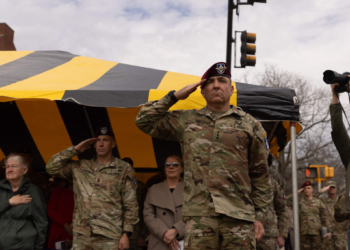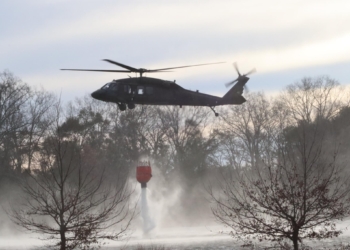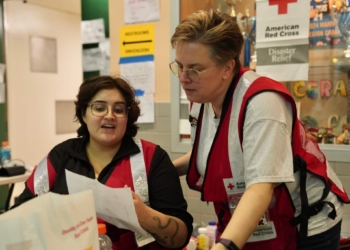Members of the National Guard, Army Reserve and Coast Guard are performing search and rescue operations in response to Hurricane Ian, as relief organizations announce disaster assistance for those affected.
Florida Gov. Ron DeSantis’ office announced 5,000 Florida National Guard members were approved for state duty, with another 2,000 guardsmen activated from neighboring states. Ian, which has now been downgraded to a Tropical Storm, left more than 2 million throughout the state without power and caused widespread flooding, according to a press release.
Search and rescue operations have included more than 800 Army reservists and Coast Guard helicopters and fixed-wing aircraft. At the time of reporting, dozens were rescued overnight.
Disaster assistance for military families affected by Hurricane Ian
Multiple aid agencies are offering assistance for those service members and military families affected by the storm.
“Hurricane Ian is expected to be the first major hurricane to strike Florida since 2018,” said Stephanie Fox, the national media lead for the American Red Cross and a Louisiana Army National Guard military spouse. “With several close calls since then, residents may find themselves complacent or waiting until the last minute to prepare.”
Former Chief Master Sgt. of the Air Force Kaleth O. Wright, current CEO of the Air Force Aid Society (AFAS), and his team frequently assist Air Force families before, during and after natural disasters like Ian. Florida is home to 21 military bases.
“We suggest that [military families] confirm what resources are available through us, as well as the military and their respective relief societies like Army Emergency Relief, Coast Guard Mutual Assistance and Navy-Marine Corps Relief Society, along with the American Red Cross, FEMA and SBA, to name a few,” said Wright. “We suggest that military Floridians review disaster preparedness and storm updates with their local, state and federal emergency response agencies.”
The Red Cross, meanwhile, has a free emergency app that provides safety tips, weather alerts, shelter notifications and more.
Financially affording a last-minute evacuation can be a tall order in today’s economy. Fox recommended saving money by staying with family or friends who are not in Ian’s path, as well as stocking up before and after storms with emergency supplies like water, canned goods, pet food, medicines, etc. as your budget allows. Disaster assistance through established organizations like the Red Cross, she also pointed out, is always free.
“It can be overwhelming to think about leaving your home, particularly for those who are also faced with extenuating complications like financial hardship,” she said. “Keep up with local media, local officials and your office of emergency management to see what resources may [be] available, including transportation to evacuation centers.”
If you do need to go to a shelter, Fox recommended taking at least three days’ worth of personal supplies with you. Besides obvious needs like clothing and hygiene supplies, bring copies of important documents, cash, prescription medication and special items for children (extra diapers and formula), pets, the elderly and disabled.
If you’re hunkering down at home, then you need all those things plus two weeks’ worth of supplies, including non-perishable food items, a gallon of water per-person per-day, flashlights with extra batteries and a first aid kit.
Once Ian is over, it’s time to assess the damage to your home, vehicles and other possessions.
“We suggest that [military families] contact their insurance carriers if they need to file a claim,” Wright said. “However, we [at AFAS] are here to provide disaster relief in the form of emergency financial assistance before and after the storm.”
The Red Cross also has a special program for military members and their families called Hero Care Network. To access this confidential assistance, you can submit a request online, download the free app or to call 1-877-272-7337.
“As I know firsthand, military families are resilient and strong,” Fox said. “But there is no doubt that catastrophic weather events like these can put a strain on families, particularly when a service member is deployed or their unit has been called up.”
Direct support for Coast Guard families announced
The Coast Guard Foundation announced Thursday activation of its emergency disaster relief program.
“When weather disasters like this strike, Coast Guard members are our first responders,” said Susan Ludwig, president, Coast Guard Foundation. “They leave their own families and damaged homes and property to step in to aid their neighbors who are in distress. Our emergency relief program offers our full support to Coast Guard heroes when and where they need us the most.”
It is estimated that more than 5,000 Coast Guard members and families live and work in the storm’s path and could be impacted by the damaging effects of Hurricane Ian, according to the announcement.
To apply for assistance, visit Coast Guard Foundation.
Other relief organizations by service branch
Navy-Marine Corps Relief Society
FEMA also announced survivors who live in Charlotte, Collier, DeSoto, Hardee, Hillsborough, Lee, Manatee, Pinellas and Sarasota counties can apply for federal assistance by visiting the disaster assistance website.
Read comments






































